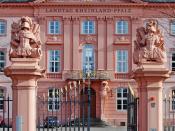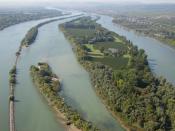Rheinland-Pfalz is one of the largest states in Germany, in population, size, and opportunity. It began as an occupied war zone after World War I. The states beautiful location has aided its special development since the Middle Ages. Once it became recognized as an independent state, it adopted its own unique customs. The capital Mainz, which is located just off of the Rhine River, is a huge economic leader.
Rheinland-Pfalz used to be called Rheinland-Palatinate. Palatinate is an ancient Roman word meaning "officer." After World War I, France, Great Britain, and the United States controlled the area called the Rhineland through the Treaty of Versailles. France created Rheinland-Palatiniate as a part of its Occupational Zone. It included the southern part of the former Prussian province Rheinprovinz (Rhineland), part of the Prussian province Hessen-Nassau, part of Rheinhessen (Rheinhessen was a part of the free state Hessen-Darmstadt), and the Bavarian Rheinpfalz.
There were thirty-nine counties put into five districts: Koblenz, Montabaur, Pfalz, Rheinhessen and Trier until 1972. After 1972, Rheinland-Pfalz became reorganized.
Important Dates in Rheinland-Pfalz's History:
February 25, 1947
The Allied Powers declared the State of PreuÃÂen (Prussia) dissolved.
April 1, 1949
The French Occupation Zone was joined with the Bizone (combined British and US Zone) to form the Trizone (Trinationalzone).
May 23, 1949
The Federal Republic of Germany was founded, and Rhineland-Palatinate became a federal state. The Pfalz was to remain separate within the state until 1968.
1968-1972
Counties and districts were reorganized. The number of districts was reduced to three: Koblenz, Rheinhessen-Pfalz, Trier, and the thirty-nine counties became only twenty-five.
Rhineland-Pfalz borders France, Saarland, Luxembourg and Belgium. The Rhine Valley is bounded by mountain chains and forms a fascinating landscape with some of the historically most significant places of Germany. The southern section of the Eifel mountains are...


